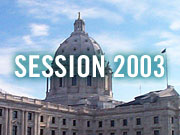Your Voice
| |||||||||||||||||||||||||||||||||||||||||||||
As budget deadline looms, the houses remain divided
April 29, 2003
Leaders in the Minnesota House and Senate plan to pass all of their budget bills by the end of the week. That gives them less than three weeks to work out their differences -- including a key issue that separates the two chambers. The House bills don't raise state taxes, while the Senate bills do, to restore funding for some of the budget cuts proposed by House Republicans and Governor Pawlenty.
St. Paul, Minn. — The 10 budget bills moving through the House closely mirror Gov. Pawlenty's budget proposal. Republican House Speaker Steve Sviggum says the House will stand by the governor's no-tax-increase pledge.
"The bottom line is, Republicans and a Republican governor are not going to increase a tax burden on any working family in the state," Sviggum says. "Now to do that, that means we have to make some reductions."
Sviggum says the House bills reduce spending while preserving the core functions of government. Senate DFL leaders disagree.
"Nothing is more core than making sure that our communities are safe, and that there is the administration of justice," says Sen. Jane Ranum, DFL-Minneapolis, who chairs the State Government Budget Division.
Ranum's budget bill would cut the courts by 1 percent. The governor and House have proposed cuts to the court system ranging from 2 percent to 10 percent. The judiciary spending bill that passed the House would also cut spending on victims' services and battered women's shelters.
Ranum says House Republican leaders and Gov. Pawlenty talk about public safety, yet they propose criminal justice cuts.
"Between the cuts to the court and the public defense, I can tell you that you will have cases dismissed. You will have cases that aren't charged," says Ranum. "And what that means is, you will have victims who have suffered and they will not have their day in court."
Ranum's bill is headed to the Senate floor.
Last week, the Senate passed a $2.7 billion higher education funding bill. It, too, spends more than the House bill, but would still cut funding for the University of Minnesota and the MnSCU system from current spending levels. The Senate bill funds the state grant program, which helps students at both public and private schools, at its current level.
The sponsor of the House higher ed bill, Rep. Doug Stang, R-Cold Spring, says the House wants to increase funding for the state grant program.
"It's one area of the budget where there's going to be actual new dollars," says Stang. "I think that shows a strong commitment to our lowest and middle-income students to try to offset this tuition hike that's coming."
Stang's bill also spends $50 million more than Gov. Pawlenty's budget proposal. Higher education is one of the few areas where the House has veered from the governor's blueprint.
Another is a subsidy for ethanol producers, which is included in an environment and agriculture spending bill that passed the House. The governor would cut ethanol producer payments to 10 cents a gallon, while the House would fund the payments at 13 cents a gallon. Overall, the bill would spend slightly more than the governor's recommendation, but would cut spending on environmental and agriculture programs from current levels.
Democrats voted against the bill. House Minority Leader Matt Entenza says House Republicans would cut environmental protection programs, and eliminate funding for the Science Museum over the next two years. Entenza says House Democrats have a plan that would minimize budget cuts.
"When we have a DFL plan that's out there that the majority could have adopted, that would have offered a maximum cut of 6 percent, at the same time holding higher education without cuts, protecting our K-12 system, you have to ask, why would we go this way?" says Entenza.
The House DFL plan, like the Senate budget, would raise income taxes on the state's wealthiest taxpayers. The Senate plan would also increase the state's cigarette tax, gas tax and license tab fees.
If the House and Senate pass all of their budget bills by the end of the week, that would leave a couple of weeks for conference committees to resolve differences in the bills. With the House and Senate budget plans about $1 billion apart, legislative leaders know it will be no easy task to reach agreement by the May 19 deadline for adjournment.
|
News Headlines
|
Related Subjects
|

